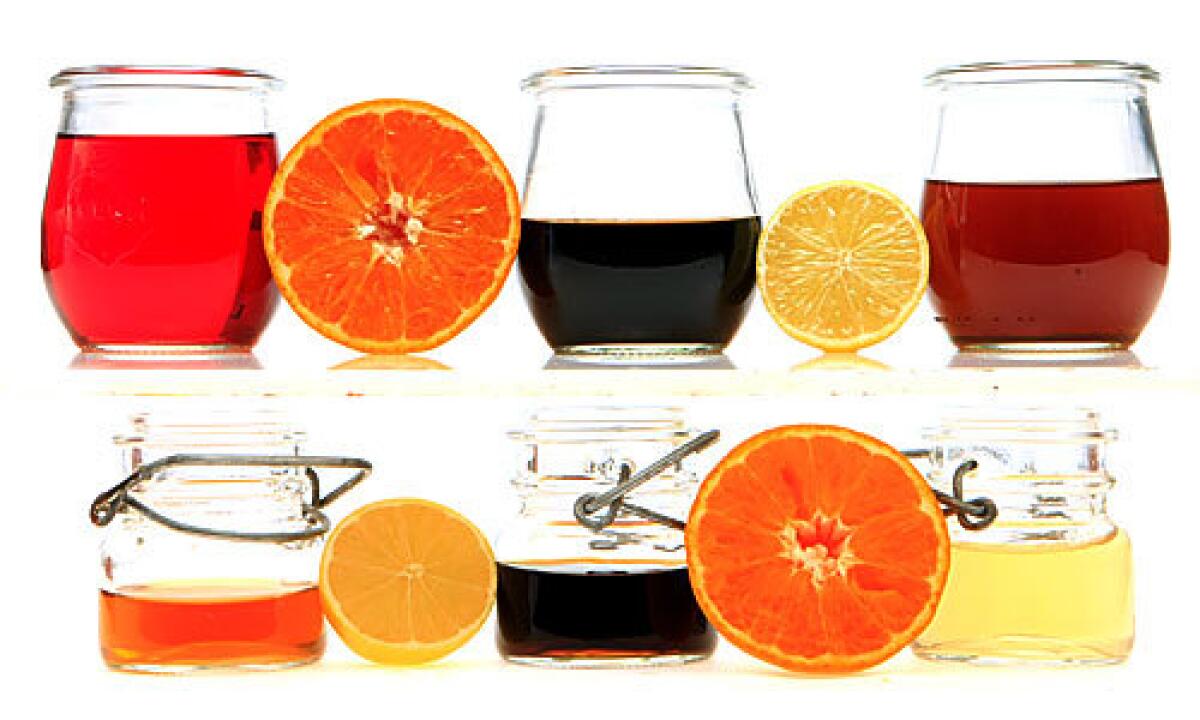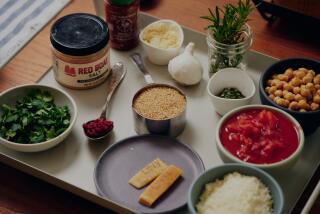A splash of seasoning can be better than a shake

When most cooks read “season to taste,” they automatically reach for the salt shaker. That’s not a bad start: A judicious sprinkling with salt will awaken many a dull dish. But if you stop there, many times you’ll be missing a key ingredient. Because just as a little salt unlocks flavor, so can a few drops of acidity.
Add a shot of vinegar to a simple stew of white beans and shrimp and notice how the seemingly simple, earthy flavor of the beans suddenly gains definition and complexity. Do the same thing with a soup of puréed winter squash and see how a dish that once was dominated by rich and sweet now has a round, full fruit character.
Though the results may be similar, salt and acidity work slightly differently. Salt is a flavor potentiator -- in other words, it works chemically to make other flavors taste more of themselves. Acidity works as seasoning by giving a dish backbone or structure, which allows other flavors to stand out and shine.
It doesn’t take much. Just as with salt, you don’t want to taste the seasoning itself; you just want the effect it has on other flavors. Sometimes only a couple of drops of lemon juice will be all that it takes.
Most cooks understand this, at least on a subliminal level. After all, what would a salad taste like dressed only with oil? It’s the vinegar that makes vinaigrette. And think of the way just a squirt of lemon elevates the flavor of a simple piece of broiled or grilled fish.
How many times have you deglazed a roasting pan with red wine? It’s not just the fruit flavor you’re after, but the acidity. Cooking down tomatoes in a pot of sauce or soup has much the same effect.
Sweet and tart
If you’ve heard waiters go on about a “gastrique” served with a dish; it’s basically a syrup of boiled vinegar and sugar. Traditionally, it is used for seasoning dishes in which meat is combined with fruit. Used clumsily (as it too often is these days), it’s nothing more than a fancy version of sweet and sour sauce.
I wouldn’t think of cooking vegetables without at least tasting for acidity -- a squirt of lemon for sautéed broccoli, a hit of red wine vinegar for summertime ratatouille. And almost every time I cook fruit, there’s bound to be a jolt of some kind of citrus to balance the sweetness.
But all acids are not created alike; this is cooking, not chemistry. Any well-stocked pantry should have several to choose from, each having its own character and flavor, in addition to that wonderfully useful tartness.
Start with citrus fruit: Lemons are the most common and probably the most useful because they generally are harvested so early that they don’t have much flavor besides their tartness. (Meyers, which are almost always harvested fully ripe, are an exception.) Oranges have a softer, sweeter sourness than lemons, and limes are tart but have a bracing herbaceous quality.
Then there is vinegar, or more appropriately, vinegars. Every pantry ought to have several of them, even if they rarely do. It’s funny how even cooks who brag about their assortment of $30-a-bottle extra-virgin olive oils will make do with only a couple of cheap vinegars.
This is silly when good vinegars offer much more variety and typically can be found for less than $15 a bottle (rarities such as true aceto balsamico and aged Vinaigre de Banyuls aside).
Though there are a lot of fancy flavored vinegars out there, you should first concentrate on getting very good examples of the basics before going crazy exploring things like fig-balsamic.
The mainstay acid for every cook should be a very good quality red wine vinegar, one that tastes like an extremely tart but otherwise well-made red wine. Unfortunately, these are hard to find commercially -- most of them taste acrid and chemical.
Fortunately, they are incredibly easy to make at home. Here’s the outline: Buy a couple bottles of decent, fruity wine, such as a Zinfandel or a Syrah. Put them in a jar with a bottle of unpasteurized commercial red wine vinegar (or a starter you’ve borrowed from a friend). Cover the jar with a cloth napkin secured with a rubber band to let in the air and keep out the fruit flies. Leave in a cool, dark corner of the kitchen for a month or a month and a half. That’s it.
Good white-wine vinegars are harder to make at home because they oxidize quickly. But the standard restaurant supply model made by Vilux is clean and perfectly acceptable. Or use Champagne vinegar, which is sharp with a subtle sweetness. Rice vinegar is also sweet, but with a rounder texture.
Balsamic vinegar is known for its sweetness, but in a burnt-sugar-caramel kind of way that doesn’t fit most culinary purposes (and certainly not salads). It is useful in marinades, though, or brushed on a piece of meat before grilling. Sherry vinegar has a distinctive nutty, wine-like quality and great depth of flavor.
Finally, don’t overlook that old American standby, apple cider vinegar. Good ones have terrific fruit character. Look for bottles that are unfiltered or unpasteurized.
How do you decide which one to use with a particular dish? Until you get an instinctive feeling for the different vinegars, the best solution is simply to try them all.
That doesn’t mean dumping vinegar after vinegar into the cooking pot, of course. Instead, use a quarter-cup measure to ladle out some of the soup or stew and add a few drops of vinegar to it. Try a couple of different ones and see which you like best.
You’ll probably be surprised at how much difference there is. The other night I made a butternut-squash soup with ginger that needed a final lift of acidic seasoning.
Intuitively, I thought a squeeze of orange would probably be the right answer, but I decided to try several alternatives as well. Good thing. Orange juice was just fine, but the flavor of the fruit was too forward -- it tasted like squash-and-ginger soup with orange. I didn’t want a distinctive flavor, I wanted a subtle hint.
Sherry vinegar worked well too, but again, its definite wine-like character stood out too much. Balsamic vinegar was not good: too soft and sweet. Neither was red wine vinegar. When I added enough to sharpen the flavor, the wine character was jarring.
Invisible flavor
Finally, I grabbed a bottle of apple cider vinegar and tried that. It was just the ticket. Though the vinegar by itself had a pleasant, identifiably apple flavor, when added to the soup it disappeared, leaving behind what seemed like just a more profound squash flavor.
Once I’d decided which acid to use, the question was how much. Just add it a little at a time until you find the right amount. For an eight-cup batch of soup, I added it in half-teaspoon doses until I got just the right effect with a little more than a tablespoon. Remember to go slowly -- you can always add more, but you can’t take away.
Acidity can also work in surprising ways. Adding a little sour can help smooth out bitter flavors. The other night I made a soup from greens I’d harvested from my garden. Because dandelions predominated the mix (go figure), the soup had a sharp, pointed bitterness. Adding a little sherry vinegar rounded out the flavors, adding a quality that was almost sweet.
You need to be careful when adding acidity for more reasons than just its pungent effect on taste. Because acids are not just flavors, they’re chemicals.
The most obvious potential negative effect of acidity is that it discolors green vegetables, turning them olive drab (it changes the chemical structure of the chlorophyll pigment). “But wait!” you say, “I thought that was because of overcooking.” Well, that’s right too -- the overcooking releases natural acidity from the plant itself, which causes the color change.
Acidity will also affect the texture of any kind of protein, “cooking” it without heat. But if left to marinate too long, it will break down the structure and create a mealy texture. Along the same lines, it will curdle cream if a sauce is too acidic. Also, it will delay the softening of dried beans if added too early in the cooking process.
At the same time, there are occasions when acids are used strictly for their chemical properties, with no flavor effect at all. Probably the most notable is when you use sour ingredients in pastries, such as pie crusts, cakes or even pancakes. You usually don’t add enough to change the flavor, just enough to weaken the flour’s gluten, creating a more tender texture.
Would you ever have guessed that just a little squeeze of something sour could accomplish so much?
More to Read
Sign up for The Wild
We’ll help you find the best places to hike, bike and run, as well as the perfect silent spots for meditation and yoga.
You may occasionally receive promotional content from the Los Angeles Times.








